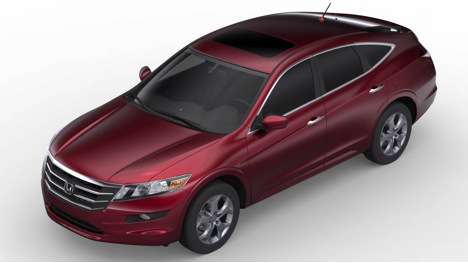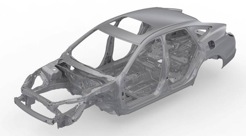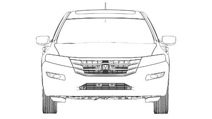2010 Honda Accord Crosstour: Body

2010 Honda Accord Crosstour body
Summary
The Honda Accord Crosstour's styling and body construction evolved from the sophisticated foundation of the Accord Sedan. Architecturally similar to the distinctive shape of the Accord, key differences can be found throughout the entire body. No exterior panels are shared with any other Accord. The most noticeable differences include the overall height of the body from the floor to the roof and the obvious design differences in the rear of the vehicle to accommodate the sloped roofline and the tailgate.
The heightened body dimensions combined with increased ground clearance result in a commanding view of the road and a comfortable hip point for ease of entering and exiting the vehicle. Structural technology includes the Advanced Compatibility Engineering™ (ACE™) body structure, an exclusive body design that enhances occupant protection and crash compatibility in frontal crashes. Extensive application of high-strength steel (46 percent) contributes to high levels of torsional and static rigidity, reduced weight, and enhanced safety potential. Aerodynamic performance is increased through strategic use of under-body covers and strakes.
Body Highlights
- Highly efficient, highly rigid and lightweight body
- Efficient collision load paths with ACE Body Structure and load-dispersing inner frame
- Active Control Engine Mounts
- Aerodynamic body shape with optimized body components
- Triple seam-sealed doors
| Accord Crosstour | Accord V-6 Sedan | Toyota Venza | Nissan Murano | |
| Length, in. | 196.8 | 194.3 | 189.0 | 188.5 |
| Width, in. | 74.7 | 72.7 | 75.0 | 74.1 |
| Height, in. | 65.7 | 58.1 | 63.4 | 67.0 |
| Wheelbase, in. | 110.1 | 110.2 | 109.3 | 111.2 |
| Ground Clearance, in. | 6.0 | 5.7 | 8.1 | 7.4 |
Exterior Styling Concept
The exterior styling builds on the Accord's familiar character lines and adds a bolder front grille complemented by a durable lower-body appearance, wedge-shaped D-pillars and an aggressive rear stance. The designers sought to build on the Accord's style that is already powerful, bold and sophisticated. Like the Accord Sedan, the Accord Crosstour's design is both sharp and strong, with a powerful-looking stance. Starting at the front, the Accord Crosstour's front fascia is enlarged and raised for dynamic toughness, and incorporates a wider and taller 6-point grille with large, horizontal slats surrounded by sharp and wide projector beam headlights. Well-defined wheel arches convey a strong stance and muscular tension. The fender lines appear broadened, like strongly muscled shoulders, with prominent character lines that sweep along nearly the entire body sides, subtly transitioning from an inverse line to an external line. Besides providing visual distinctiveness, these character lines communicate strength and structural depth. The flowing roofline narrows smoothly into the rear of the vehicle to create an aggressive-looking design, concealing a unique cargo area that can adapt to large objects that exceed the capacity of a normal sedan.
Body Construction
Increased rigidity enables enhanced vehicle dynamics, ride comfort and driving quietness. The Accord Crosstour is constructed of 46 percent high strength steel (340 grade or above) to create a strong, yet lightweight body with high rigidity and enhanced safety. The ACE Body structure further enhances frontal collision compatibility between vehicles with different bumper heights. The Maximum Efficiency Floor (MEF) design is comprised of a network of longitudinal rails, floor cross-members and pillar reinforcements that carry heavy loads to enhance crash safety, handling and packaging efficiency. High tensile strength steel tubular beams inside the door structure provide additional intrusion resistance.

2010 Honda Accord Crosstour body in white
Noise, Vibration and Harshness (NVH) Reduction Features
The Accord Crosstour is designed to drive exceptionally smooth and with reduced noise intrusion into the cabin. To accomplish this, the vehicle approaches NVH reduction from two primary directions - traditional insulation in the floor, doors and firewall; and active systems that work with the engine and audio system to cancel certain types of unwanted engine noise. A triple door-seal system is used to minimize wind and road noise. Strategic use of insulation in the rear fender wells also minimizes road noise.
Aerodynamic Enhancements
Aerodynamic performance is increased through the use of body under covers, a deflector under the front bumper, front strakes, the optimum inclination of the tailgate and an effective rear spoiler.

2010 Honda Accord Crosstour front view showing strakes by wheels
Ground Clearance
The ground clearance for the majority of the underbody area measures 8.1 inches and contributes to the Accord Crosstour's commanding presence compared to the Accord Sedan. The front strakes represent the lowest point under the vehicle at 6.0 inches (the official ground clearance number for EPA measurement purposes).
Active Control Engine Mounts
The Active Control Engine Mount (ACM) system is used to minimize the effects of engine vibration caused by the VCM system when cylinders are deactivated. During cylinder deactivation, the Powertrain Control Module (PCM) instructs the ACM actuators to move in concert with the engine motions to effectively cancel the vibrations inherent to cylinder deactivation. Inside the cabin, the audio system-based Active Sound Control (ASC) further minimizes any unwanted sound relating to the function of the VCM system. (Please see the Interior section for more information.) Together, these innovations help make the implementation of fuel saving technology transparent and seamless to the driver.
Glass and Visibility
The Accord Crosstour was designed to provide excellent outward visibility, improving the comfort and convenience for all occupants. A large greenhouse creates excellent outward visibility. Deeply tinted privacy glass is used in the rear side doors, wedge-shaped rear quarter windows and rear tailgate.
Tailgate
The Accord Crosstour's front-hinged tailgate design creates a wide opening into the vehicle of 38.5 inches (980mm) and a low lift-in height of 28.4 inches (721 millimeters). The hinge design is configured so that the user does not have to step backwards when the door is opening or shutting. The tailgate includes a large upper window and a smaller lower window for increased rearward visibility at lower sight angles. The lower window allows for objects like a 3.3-foot (1 meter) tall parking lot pole to be spotted at distances as close as 5.3 feet (1.6 meters). Comparatively, some CUV designs that lack a lower rear window require approximately 6.5 feet or more to spot the same 3.3-foot pole. The upper tailgate glass incorporates an intermittent rear wiper and washer nozzle. An electric defogger system is incorporated into the upper and lower glass sections.
The tailgate locks and unlocks with the interior's door locks. To open, an electronic switch under the license plate awning releases the tailgate when the vehicle is unlocked. For ease of closing, a grip handle is located under the tailgate base. The tailgate can be opened in tight parking situations, requiring a minimum of 5.9 inches of space between the leading edge of the tailgate and a potential obstruction like a nearby vehicle or wall. Two gas-filled struts support the open tailgate.
Headlights and Taillights
The Accord Crosstour is equipped with halogen projector-beam headlights for low beam illumination and conventional reflective halogen high beam headlights. Projector-style headlights provide a distinctive and sporty appearance with a bright, focused beam for a superior, even distribution of light compared to conventional reflector lens designs. The standard fog lamps are integrated into the front bumper. The taillights convey a deep three-dimensional appearance with layered inner lines that wrap from the back of the vehicle into the fenders. A clear lens for the backup light punctuates the overall red design. The taillight housings integrate a side reflector and turn signals in addition to the running lamps and the stop lights.
Door Design and Construction
The Accord Crosstour's doors are designed to operate with solid precision with a convenient three-stage detent hinge. Additional premium features include triple seals in the bottom of the door structure to better insulate the cabin from road noise. Triple seals also serve to keep moisture, dirt and road grime away out the kick panel area – a space that can sometimes come into contact with clothing while entering or exiting the vehicle. All door handles are soft to the touch underneath to improve operating comfort.
With the key inserted, the door lock cylinders can raise and lower the windows and open/close the moonroof by turning clockwise for up and counter-clockwise for down. The unlock button on the key fob will lower the power windows and open the moonroof when depressed for three seconds and then continuously held.
An automatic door locking/unlocking system is customizable by driver preference. Automatic locking can be linked to vehicle speed reaching 10 miles per hour (15 km/h), or the gear shift lever shifting from park, or it can be deactivated entirely.
Automatic unlocking, configurable to the driver's door or all doors, can be linked to the ignition switch being turned to the off position, or the gear shift lever being positioned in the park position, or it can be turned off entirely. The factory default for locking is linked to vehicle speed. The factory default for unlocking is linked to the gear shift lever and unlock activation for the driver's door only.
Side Mirror
The vehicle's side mirrors are aerodynamically optimized to prevent wind noise and minimize turbulence. When the driver puts the transmission in reverse on the Accord Crosstour EX-L model, the driver or passenger-side mirror can tilt down (depending on left/right/off mirror switch position) to reveal curbs and ground level obstacles. The Accord Crosstour EX-L model includes mirror position memory linked to the driver's seating profile (activated with the key fob or the controls near the driver's door release). All models feature heated side mirrors as standard equipment.
Moonroof
To tilt or slide the moonroof the driver or front passenger needs only to fully press the ceiling-mounted switch once (instead of pressing and holding it for several seconds). The moonroof fully opens or closes automatically. However if the operator wishes to only partially open or close the moonroof (such as to achieve partial ventilation), a lighter touch yields fully manual control. The moonroof can also tilt to provide ventilation. An auto-reverse feature is built in, helping to ensure that the moonroof will not forcefully close if someone's hand or arm is positioned in the path of the moonroof. If an obstruction is detected, the moonroof mechanism will reopen the moonroof.